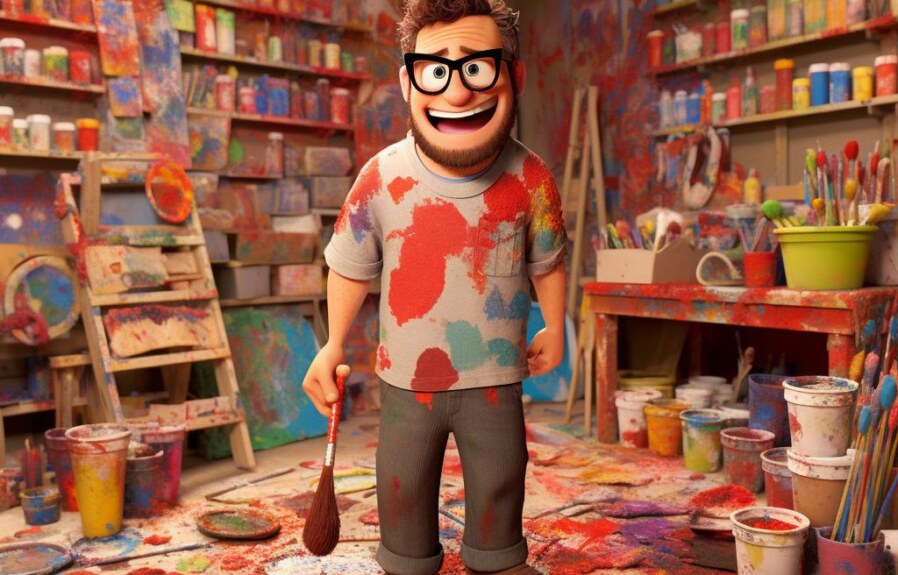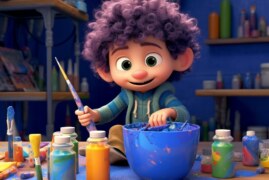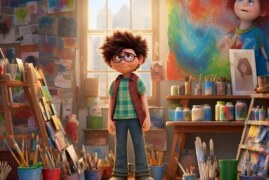Red is an incredibly dynamic and potent color in the world of art and design. It reflects passion, power, energy, and determination. No wonder, many artists crave the perfect shade of red for their artwork. While red paint is readily available in stores, it’s not always easy to find the exact shade you desire. That’s where creating your own red paint comes in handy. Making red paint can open up a world of possibilities, allowing you to create custom hues that perfectly match your vision. In this article, we’ll explore different methods to help you learn how to make red paint that’s perfect for your next project. From natural pigments to synthetic dyes, we’ll guide you through everything you need to know to make red paint. So, let’s dive in and unleash our inner artists, shall we?
1. Understanding the Color Red: An Introduction to Color Theory
In the world of the arts, color is undoubtedly one of the most essential elements in creating an artwork. Understanding colors and their properties is crucial in producing a successful piece of art. Red is a primary color that is considered to be one of the most vibrant, passionate, and captivating colors.
Primary, Secondary, and Tertiary Colors
Color theory is a fundamental concept in art and design that refers to the relationships and harmonies between colors. The primary colors are red, blue, and yellow. They are the building blocks of all colors that are used in creating art. Secondary colors, on the other hand, are created by combining two primary colors. When red and blue are mixed, the result is purple. When red and yellow are mixed, the result is orange. Lastly, tertiary colors are created by mixing one primary and one secondary color.
Warm and Cool Colors
Warm and cool colors are another essential concept in color theory. Warm colors are hues that are considered to be more energetic and vivid, such as red, orange, and yellow. Meanwhile, cool colors are hues that are more calming and soothing, such as blue, green, and purple. Red is usually considered a warm color because of its association with passion and intensity.
In summary, understanding color theory is crucial in creating an artwork that effectively communicates its message. Red is a primary color that is considered warm, vibrant, and passionate. In the next section, we will explore the ingredients that make red paint.
2. Pigments and Binders: Exploring the Ingredients of Red Paint
In order to make red paint, we need to understand the two key components of paint: pigments and binders. Pigments are the colored particles that give paint its hue, while binders are the substances that hold the pigments together and make the paint stick to a surface.
The Pigments in Red Paint
The pigments used to make red paint come from a variety of sources, including minerals, organic compounds, and synthetic chemicals. Some common red pigments include:
- Cadmium red: A bright, opaque pigment made from cadmium sulfide. It is very popular among painters due to its vibrant color and good lightfastness.
- Alizarin crimson: A transparent pigment made from the roots of the madder plant. It has a rich, deep color but can fade over time.
- Quinacridone red: A synthetic organic pigment that has a high tinting strength and good lightfastness. It is often used in automotive paints.
The Binders in Red Paint
The binder used in red paint is usually a type of oil, such as linseed oil or walnut oil. These oils are mixed with a solvent, such as turpentine or mineral spirits, to make a paintable consistency. Acrylic binders are also common and are a good choice for those who want to avoid the toxicity of oil-based paints.
When choosing a binder, it is important to consider factors such as drying time, viscosity, and color. Different binders can affect the final look and feel of the paint, so it’s important to experiment with different options to find the best fit for your particular project.
Understanding the materials that go into making red paint is essential for achieving the perfect shade and texture. By combining the right pigments and binders, artists can create red paints that are vibrant, long-lasting, and tailored to their specific creative vision.
3. Mixing Red Paint: How to Achieve Different Shades and Tones
How To Make Red Paint: Mixing Red Paint
How to Achieve Different Shades and Tones
Mixing different shades of red paint can be an art in itself. Depending on the amount of pigment and binder you use, you can achieve a spectrum of hues that range from pale pink to deep, dark red. Here are some tips for creating different shades and tones of red paint:
1. Start with the base color: Mix equal parts of red pigment and binder to create a base color. This will be the color you will build on to create different shades and tones.
2. Adjust the pigment: To make a lighter shade of red, add more binder to the base color. To make a darker shade of red, add more pigment.
3. Mix with other colors: You can mix red paint with other primary colors (blue and yellow) to create secondary colors such as orange and purple. You can also mix red with other shades of red to achieve various tones.
4. Experiment with ratios: For a more pastel shade of red, use less pigment and more binder. For a bolder shade, use more pigment and less binder.
5. Add white or black: To lighten or darken red paint, add white or black pigment. However, be cautious when adding black pigment as it can quickly overpower the red.
Overall, the key to achieving different shades and tones of red paint is experimentation. Don’t be afraid to play around with different ratios and colors to discover your perfect shade of red.
4. Tips for Creating Vibrant and Long-Lasting Red Paint
How To Make Red Paint:
Making your own red paint from scratch can be a fun and rewarding experience, but it’s important to follow the right steps to ensure you create a paint that is vibrant and long-lasting. Here are some tips to help you create the perfect red paint:
1. Choose high-quality pigments
The pigment you choose can have a huge impact on the quality and vibrancy of your red paint. Look for high-quality, lightfast pigments that are specifically labeled for use in paint-making. Some good red pigments to consider include Cadmium Red, Quinacridone Red, and Pyrrole Red.
2. Use a high-quality binder
The binder you choose will help hold the pigment particles together and create a smooth, consistent texture in your paint. Experiment with different binders to find the one that works best for your pigment and desired paint consistency. Some popular binders include gum arabic, linseed oil, and egg yolks.
3. Be mindful of ratios
It’s important to measure your red pigment and binder carefully to create a consistent paint formula. Generally, you will want to use about 1 part pigment to 2 parts binder, but this may vary depending on the specific pigments and binders you are using. Don’t be afraid to experiment with the ratios to find the perfect formula for your desired paint consistency and color intensity.
4. Store your paint properly
After creating your red paint, be sure to store it properly to ensure it stays vibrant and long-lasting. Store your paint in a cool, dry place, away from direct sunlight or heat sources. Consider adding a preservative, such as clove oil, to help extend the shelf life of your homemade paint.
By following these tips, you can create high-quality, vibrant red paint that will last for years to come. Be sure to experiment with different pigments, binders, and ratios to find the perfect formula for your desired color and consistency.
5. Safety Precautions When Making Red Paint from Scratch
Here are some important safety precautions to keep in mind when making red paint from scratch:
Wear Safety Gear
Always wear protective gloves, a mask, and goggles when working with pigments and binders. This will help protect you from inhaling or coming into contact with harmful chemicals.
Use a Well-Ventilated Space
Make sure you are working in a well-ventilated space to prevent the inhalation of paint fumes. It’s also a good idea to have a fan or open window nearby to help circulate the air.
Avoid Ingestion or Skin Contact
Avoid ingesting the pigments or binders and prevent skin contact to avoid any possible allergic reactions. In case of any contact, wash the affected area immediately with cold water and consult a physician if necessary.
Proper Storage
Store your pigments and binders in a dry and well-ventilated place, away from direct sunlight or moisture. Make sure to keep the containers tightly sealed and labeled to avoid accidental ingestion or mixing with wrong substances.
By following these safety precautions, you can safely and confidently make red paint from scratch and explore your creativity.
6. Experimenting with Red Paint: What to Do with Your Newly Created Masterpiece
After successfully creating your own red paint, you may wonder what to do with it. There are various ways to use red paint, and the possibilities are endless. Here are some ideas to inspire your creativity:
1. Paint a Still Life
Create a composition by arranging objects on a tabletop or create a scene from your imagination. Your newly created red paint could be used to represent flowers, fruits, or any other red objects in your painting. Experiment with different shades and tones of red to create depth and contrast in your artwork.
2. Make an Abstract Painting
Use your red paint to make an abstract painting by creating different shapes, lines, and patterns. Add other colors to create a dynamic and vibrant artwork. You could use brushes, sponges, or even your fingers to apply the paint to the canvas.
3. Create a Portrait
Paint a portrait of a loved one or yourself using your red paint. Mix in other colors to create skin tones and hair colors. Experiment with different brush strokes to create texture and different shades of red.
Remember to have fun and experiment with your red paint. Don’t be afraid to try new techniques or mix in other colors. Your newly created masterpiece is a reflection of your creative vision and imagination.
7. Conclusion: Discovering Your Creativity through Red Paint-making
The art of making red paint is not just about mixing colors and creating shades, but it is also about discovering your creativity and exploring new possibilities. Through this process, you can experiment with various shades, tones, and textures of red that are uniquely your own. Whether you are an experienced artist or just starting, the process of making red paint from scratch can provide an exciting and fulfilling experience.
Experimentation is Key
When creating red paint, it is important to remember that experimentation is key. No two shades of red are the same, and adding different pigments or binders can result in a wide range of colors and textures. Some red paints may be thicker or thinner in consistency, while others may have a matte or glossy finish. By experimenting with different ingredients and mixing techniques, you can create a unique red paint that is tailored to your individual style.
Create Your Masterpiece
Once you have created your red paint, the possibilities are endless. Whether you use it for painting, drawing, or other creative pursuits, the vibrant and unique red color you have created can add a new dimension to your artwork. You can explore new subject matter, experiment with different techniques, and create new textures and effects by using your newly created red paint. The process of making red paint has opened doors to your creativity and can lead to many exciting projects in the future.
People Also Ask:
1. What Are the Primary Colors Needed to Make Red Paint?
Red paint can be created by mixing blue and yellow primary colors. Adding more yellow paint than blue can create a warmer red and vice versa for a cooler red.
2. How Do You Make Red Paint Without Red Pigment?
One way to make red paint without red pigment is by mixing magenta and yellow paint. Magenta is a pinkish-purple color that can be found in many paint sets. Mixing magenta and yellow in varying ratios can create different shades of red.
3. How Do You Make Red Paint From Scratch?
To make red paint from scratch, you will need natural pigments such as clay, hematite, or cinnabar. Grind the pigment into a fine powder and mix with a binder such as egg yolk or gum arabic. Add water to achieve the desired consistency.
4. How Do You Make Dark Red Paint?
Creating a dark red paint involves adding a small amount of black or brown to the red paint. It is important to add the darker color sparingly as a little goes a long way.
5. Can You Mix Different Shades of Red Paint?
Yes, different shades of red paint can be mixed to create custom hues. Experimenting with different ratios of warm and cool shades can help achieve the desired color.
Conclusion:
Making red paint can be achieved using a variety of methods, from mixing primary colors to grinding natural pigments. By experimenting with different techniques and ratios, it is possible to create custom shades and meet individual artistic needs.



